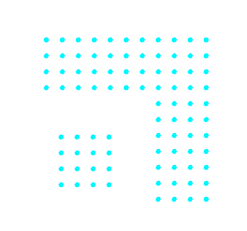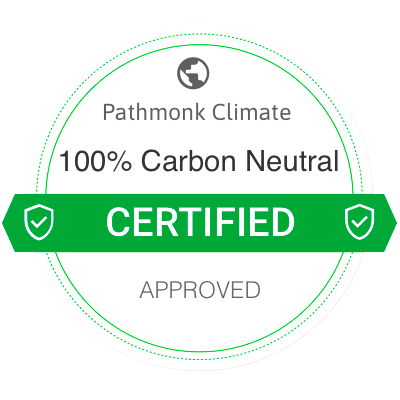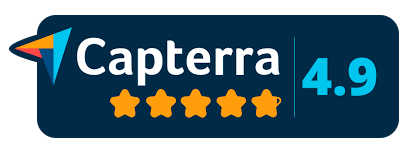If summer feels like a slow season for your pipeline, you’re not alone. From B2B tech companies to consumer brands, July and August often bring a predictable dip in website traffic, lead volume, and sales conversations. Decision-makers take vacations. Budgets stall in limbo. And marketing teams are left wondering how to keep momentum alive—unless, of course, you’re selling bikinis or renting hotel rooms.
But here’s the good news: the summer slowdown isn’t just something you have to endure. It’s actually one of the best opportunities all year to focus on the one thing that pays off long after vacation season ends: improving your conversion strategy.
When traffic is lower, the stakes are lower, too. You can finally take a step back, analyze what’s working (and what isn’t), and make meaningful changes without the constant pressure of peak season demand.
Whether you’re cleaning up analytics, testing new messaging, or fine-tuning your user experience, small improvements you implement now will compound into bigger gains when your audience comes back in full force.
Table of Contents
1. Why summer is the best time to optimize conversions
There’s a curious thing that happens when the world slows down: the noise disappears. For most of the year, your marketing engine is running full tilt—ads to launch, content to publish, leads to qualify, sales to support. It’s easy to fall into reactive mode, chasing quick wins and patching problems only when they start hurting revenue.
Summer flips that script.
With fewer distractions and a natural pause in activity, you finally have the breathing room to step back and look critically at how your website performs. Instead of just keeping the lights on, you can ask bigger questions:
- Where are visitors actually dropping off?
- Is your messaging still aligned with what your buyers care about?
- Which parts of your conversion flow are due for a refresh?
This isn’t about filling time until everyone’s back from vacation, it’s about using this seasonal slowdown as a strategic advantage.
Why?
Seasonality isn’t failure, it’s just part of the cycle
Let’s start by calling out the elephant in the room: summer traffic drops are real. In B2B, many buying committees simply aren’t around to make decisions. Sales conversations stall, proposals gather dust in inboxes, and even the most persuasive offers feel like shouting into the void.
This isn’t a crisis, it’s the reality of human behavior. A recent HubSpot benchmark showed July and August consistently bring a 20–30% dip in lead volume compared to the spring months. If you work in SaaS or other B2B industries, you’re especially likely to feel it.
Instead of panicking, use this season to zoom out and assess your conversion performance without the pressure of constant inbound noise.
Less chaos, more clarity
Think about the rest of your year. Between launches, end-of-quarter pushes, and unplanned fire drills, conversion optimization often falls into the “when we have time” bucket.
Summer changes the dynamic. Fewer campaigns are fighting for attention. Meetings slow down. Decision-makers are out of office (or at least less frantic). All of that creates space to work on projects you can never seem to prioritize, like fixing the friction in your funnel or finally updating that outdated landing page you cringe at every time you see it.
This is the moment when your team can focus on improvements that don’t have an immediate deadline attached but will quietly drive revenue later.
Early improvements multiply over time
Small wins have a sneaky way of adding up. Let’s say you make a modest tweak to your product page—maybe the headline is clearer, or the call to action feels more relevant. If that lifts your conversion rate by even 1% now, you’re putting a higher baseline in place for every prospect who hits your site in the fall.
It’s like compounding interest for your funnel. The payoff isn’t always visible in real time, but when traffic rebounds, your incremental gains become a measurable lift in pipeline and revenue.
That’s why some of the most seasoned CRO professionals actually look forward to summer: it’s when they lay the groundwork for performance spikes later.
Lower stakes mean bolder experiments
If you’ve been hesitant to try something new—whether it’s a radical redesign of a landing page or a fresh approach to messaging—summer is your window. With fewer eyeballs on your site, you have a natural safety net.
Even if a test underperforms, you’re not risking the same revenue you would during a peak campaign. And when it works? You’ll have proof of concept ready to roll out at scale when your audience comes back refreshed and ready to buy.
So, this is what you’re going to do 👇
Generate better leads to grow your sales
Discover new strategies to unlocking a flood of high-quality leads from your website.
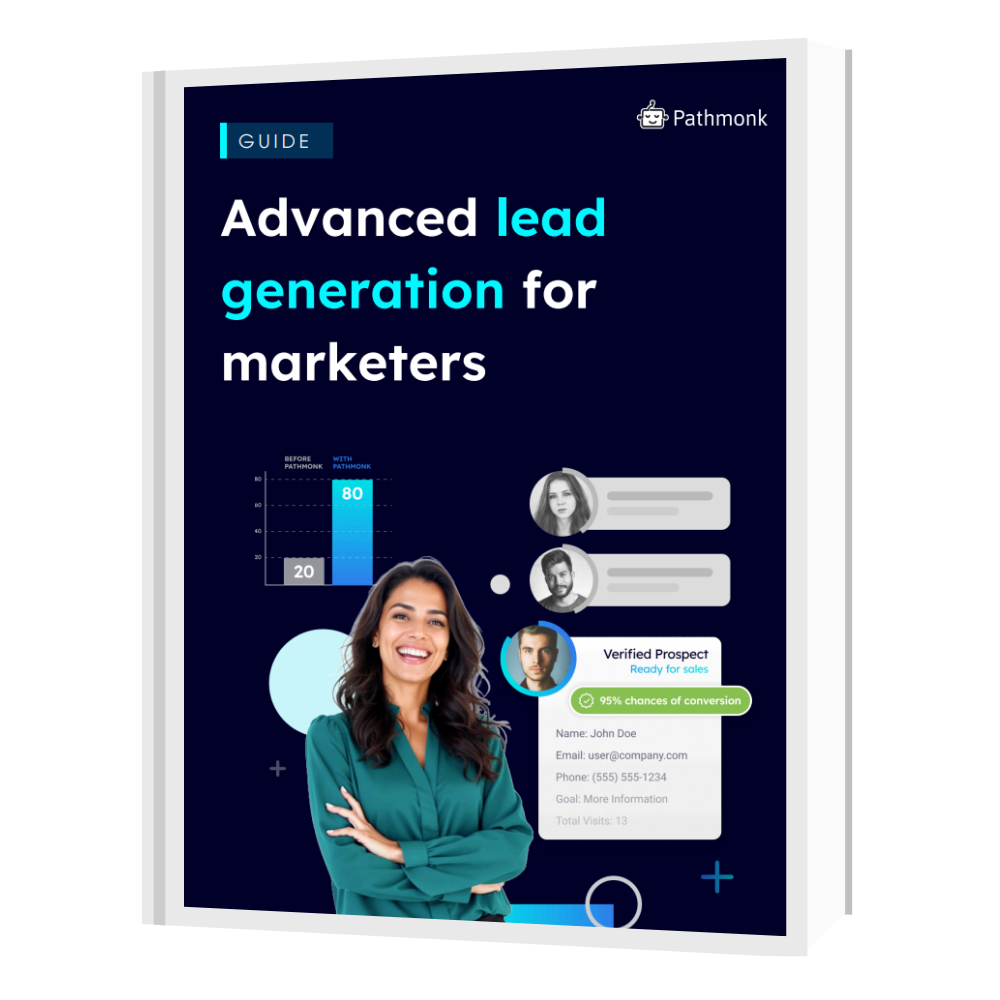
Step 1: Audit your current conversion performance
Before you jump into testing headlines or redesigning your landing pages, you need to understand what’s actually happening today. A lot of marketers skip this step because it feels tedious or too analytical, but it’s the backbone of every effective optimization effort.
Think of it like getting a physical before you start training for a marathon. Without a baseline, you’ll have no idea what’s working, what’s underperforming, or where to focus your time.
Let’s break down how to run a meaningful audit:
1. Pull and review your baseline metrics
Start by gathering the key numbers that define your funnel’s health. Don’t just grab top-line conversion rate—look deeper:
- Conversion rate by channel: Organic, paid, direct, email. You might discover your paid campaigns convert at 3x your organic traffic, or vice versa.
- Landing page performance: Which pages pull their weight? Which ones hemorrhage visitors? Use tools like Google Analytics, Mixpanel, or your CRM reports to spot outliers.
- Micro-conversions: These are the smaller steps that signal engagement—newsletter sign-ups, product page views, demo requests. If your primary conversion is lagging, micro-conversions can reveal whether interest exists but stalls somewhere in the journey.
Make sure you’re pulling at least 3–6 months of data to smooth out seasonal spikes or anomalies.
Understand your customer journey analytics
See how your users behave, find drop-offs, and receive actionable insights with AI.
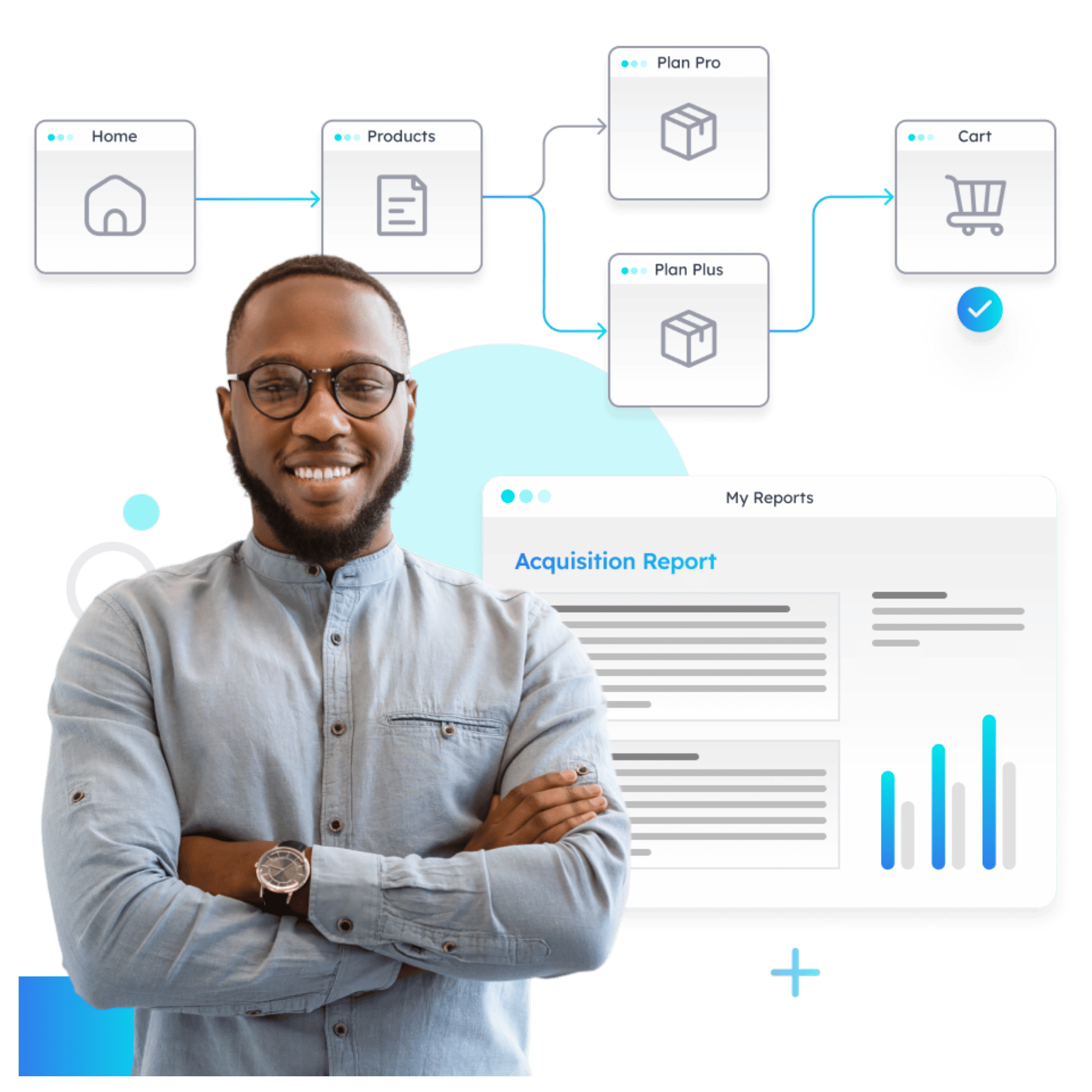
2. Observe behavior beyond the numbers
Metrics are essential, but they only tell part of the story. You also need to see how people actually behave on your site. This is where qualitative tools shine:
- Session recordings: Watching a few anonymized sessions can quickly reveal friction points, like confusing navigation or forms that drive people to abandon.
- Form analytics: If you rely on gated content or sign-up flows, look closely at field-level drop-off. Sometimes a single extra required field can tank conversions by double digits.
3. Segment your findings
One of the biggest mistakes in CRO is treating every visitor the same. Averages lie. To get actionable insights, segment your data:
- New vs. returning visitors: Returning traffic often behaves differently—sometimes converting at a much higher rate because familiarity reduces friction.
- Device type: Mobile visitors may have a different experience than desktop users. A page that converts well on desktop can quietly fail on a phone.
- Traffic source: Someone who clicks a branded search ad is often closer to purchase than someone casually browsing a blog post. Aligning expectations with their intent is key.
When you segment, you can pinpoint which groups are healthy and which need attention. This clarity prevents wasted effort fixing what isn’t broken.
4. Document everything
As you collect data, don’t just dump it in a spreadsheet and forget it. Create a structured audit report. Outline:
- What’s performing well (so you can protect it)
- What’s underperforming
- Hypotheses for why certain pages or flows aren’t converting
- Priorities for the next steps
Having this document makes it easier to share insights with your team, track improvements over time, and make informed decisions about where to invest effort.
Free template: CRO audit checklist
Discover everything you need to start identifying drop-offs and increase conversions.
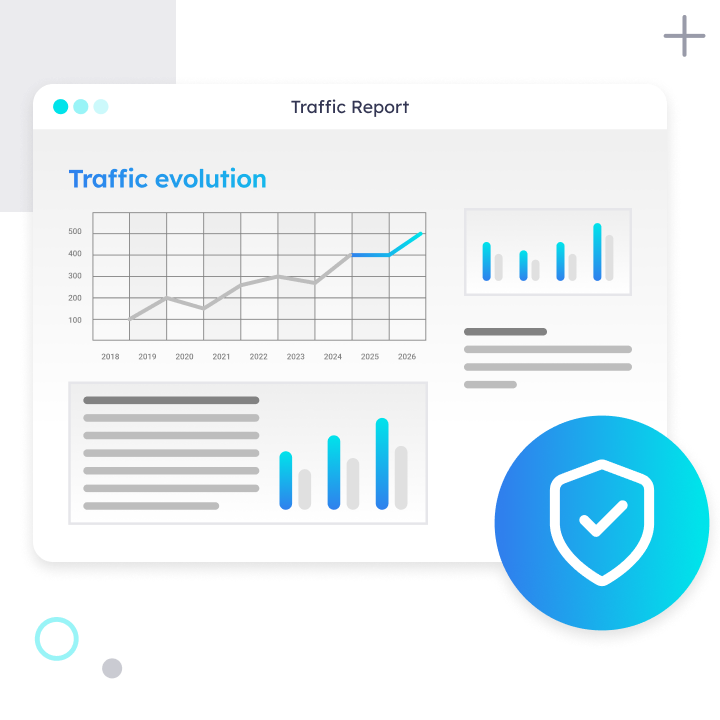
Step 2: Refresh your messaging and offers
Once you know where your conversion flow is underperforming, the next step is to examine how your messaging and offers are working—or not working—to move visitors forward.
The best-performing websites rarely win because they have the fanciest design. They win because their messaging is clear, consistent, and persuasive, and their offers feel relevant to the people seeing them. Summer is the perfect time to revisit these elements and make sure they’re still aligned with your audience’s expectations.
1. Re-evaluate your headlines and calls to action
Start with the most visible, highest-impact content: your headlines and CTAs.
Ask yourself (and ideally, your team) some hard questions:
- Does your headline clearly state what you do and why it matters?
- Is your call to action specific and compelling, or generic and ignorable?
- Have you been using the same copy for years out of habit?
One common pitfall: headlines that try to be clever at the expense of clarity. Research from the Nielsen Norman Group shows users typically spend less than 10 seconds deciding whether to stay on a page. If your core value proposition isn’t obvious in those first moments, your bounce rate will keep climbing.
Try rewriting your headline with this formula: [Desired Outcome] + [For Whom] + [Proof or Differentiator]. Example:
- Instead of: “Smarter Project Management”
- Try: “Manage Complex Projects Faster—Trusted by 5,000 Agile Teams”
For calls to action, swap vague verbs like “Submit” or “Learn More” for action-oriented phrases that set expectations, such as “Get Your Free Audit” or “Start My Trial.”
2. Evaluate whether your offers are still relevant
Your offers are the bridge between curiosity and commitment. If they no longer feel timely, your conversion rate will suffer, no matter how persuasive the design.
Look at your primary lead magnets or incentives:
- Are they still aligned with what your audience cares about?
- Do they address the challenges your customers face right now?
- Could they benefit from a seasonal refresh?
For example, if you’ve been offering a generic eBook for years, consider updating it with fresh data, a new angle, or a tie-in to current trends. Even a subtle change in framing—like positioning a resource as a “2025 Planning Guide”—can signal relevance.
If you don’t have the bandwidth to create something new, you can often improve performance by repositioning or re-packaging an existing asset.
3. Check for consistency across touchpoints
One of the fastest ways to lose credibility is to create disjointed experiences. A visitor clicks on a Google ad promising a “free demo,” only to land on a page that talks about a paid trial, then receives an email offering a discount with no mention of either.
These disconnects confuse prospects and increase friction.
Here’s a simple checklist to spot misalignment:
- Does the headline on your landing page match the promise in your ad?
- Do your emails reinforce the same core benefits your website emphasizes?
- Are your CTAs consistent across pages and channels?
If you find inconsistencies, summer is the ideal time to clean them up. A unified message builds trust and makes it easier for your audience to say yes.
Pro tip: While you’re refreshing your messaging, document the before and after versions. This way, you’ll be able to track the impact of each change and learn which adjustments resonate most with your audience.
Free template: customer journey touchpoints
Map your marketing touchpoints and understand your users' journey to conversion across all stages
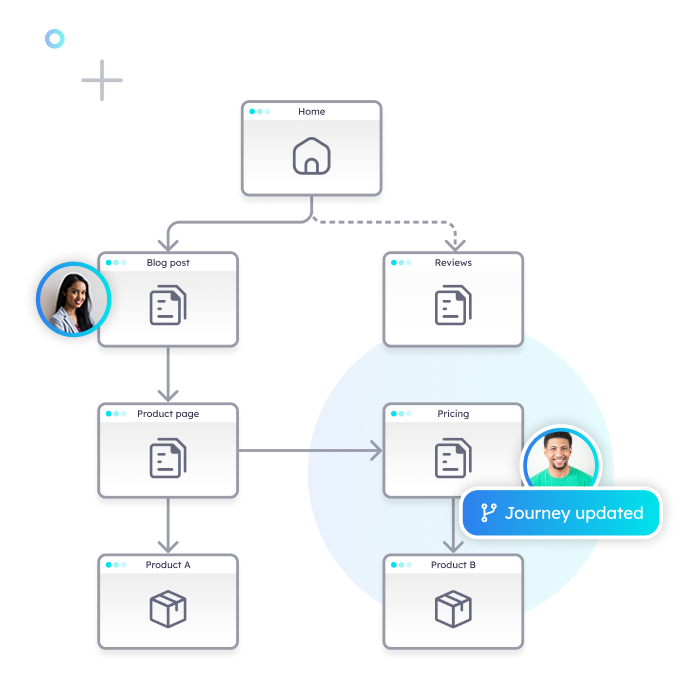
Step 3: Strengthen your website experience
Summer is a rare chance to look at your website with fresh eyes, not as the marketer who built it, but as the customer who lands there, hoping to find answers.
Instead of getting lost in technical details, focus on practical improvements that you can own and that make the overall experience more persuasive and friction-free.
1. Do a “first impression” walkthrough
It sounds almost too simple, but reviewing your own site the way a prospect would can reveal glaring issues you’ve overlooked.
Try this exercise:
- Open your homepage in an incognito window on your laptop and phone.
- Pretend you know nothing about your product or brand.
- Answer these questions honestly:
- Is it immediately obvious what problem you solve?
- Do you feel confident about what to do next?
- Are there any points where you hesitate or feel overwhelmed?
Ask a colleague—or even a friendly customer—to do the same. You’ll often spot confusing layouts, outdated messaging, or content gaps that don’t require any code to fix.
2. Refresh visuals and social proof
Visual fatigue is real. Over time, the images, testimonials, and logos on your site can lose their impact simply because they’ve been there forever.
Summer is the perfect time to:
- Swap out dated product screenshots for newer versions.
- Rotate in fresh customer logos or success stories.
- Update headshots of team members if you have a “Meet the Team” section.
- Refresh hero images so your site feels current.
These small changes can instantly lift perceived credibility without requiring a full redesign.
3. Simplify your navigation
When was the last time you looked critically at your main navigation menu?
A cluttered nav can silently erode conversions. Use this slower season to:
- Trim your menu to focus on the 3–4 most important destinations.
- Make sure your CTAs are consistent and clear across the site.
- Remove old promotions or outdated links that create friction.
This is the kind of low-effort, high-impact maintenance that pays off when traffic rebounds.
4. Test your site’s journey on mobile
While you don’t need to get technical, it’s smart to confirm your core flows feel smooth on a phone. With so many buyers browsing on mobile—especially during travel season—a clunky experience can cost you.
Check:
- Does the page load quickly enough to feel responsive?
- Are buttons and forms easy to tap?
- Do pop-ups and chat widgets behave themselves, or do they block content?
If you spot issues, you can flag them to your web team or agency, but the main point here is awareness and prioritization—not hands-on fixing.
Step 4: Run low-risk A/B tests
Once you’ve refreshed your messaging and cleaned up friction points, summer is the perfect time to try experiments you normally wouldn’t attempt in the middle of a big campaign. Lower traffic gives you a safe space to test new ideas without the fear of disrupting revenue.
Most marketers think A/B testing is about tweaking a headline or swapping button colors. Sure, those small adjustments can help, but they rarely create meaningful lifts. The bigger opportunity lies in testing personalization itself: showing each visitor content that adapts to their intent and behavior in real time, like Pathmonk does.
Unlike traditional CRO tools that require manual segmentation and endless rule-building, Pathmonk uses AI to do the heavy lifting for you.
Here’s how it works:
- Detects buying journey stage automatically. Pathmonk tracks behavioral signals—like how often a visitor returns, what pages they browse, how long they stay, and which actions they take. Based on these signals, it predicts whether someone is in an early awareness phase, comparing options, or ready to buy.
- Creates dynamic micro-experiences. Depending on where someone is in their journey, Pathmonk can automatically show the most relevant content. For example:
- First-time visitors might see a short explainer video.
- Returning visitors might see testimonials or case studies.
- High-intent prospects might get a clear prompt to book a demo.
- Runs controlled A/B tests. You can split your audience into two groups: one experiences your usual, static website, and the other sees personalized content. Pathmonk measures exactly how personalization affects engagement, conversion rates, and leads generated.
All of this happens without developers rewriting your site or you spending weeks configuring complex rules. You simply define your main goal—like demo bookings or sign-ups—set up the Pathmonk tag, and let the AI do the rest.
Even better, the first month is free, so you can run real tests this summer with no upfront cost. You’ll walk away with clear data showing whether personalization moves the needle for your audience—so you’re ready to scale successful experiences when traffic rebounds in the fall.
If you’ve been waiting for the right time to try a smarter approach to A/B testing, summer is your moment.
How WestEnd Motorsports increased conversions by 286% with Pathmonk’s A/B testing in just 14 days
Let’s look at how one e-commerce brand used Pathmonk’s A/B testing to prove exactly how much AI-powered personalization could impact their sales—without redesigning their website or increasing their ad spend.
WestEnd Motorsports is a well-known online store for motorcycle parts and accessories. They have thousands of products, from exhaust systems to seats, covering every major bike model. While their SEO and paid campaigns consistently brought in traffic, the shopping experience had a big challenge: product overload.
Too many options made it overwhelming—especially for first-time or less technical customers. Even if someone was excited to buy, they often bounced before figuring out which parts fit their motorcycle.
To solve this, their agency, Coalition Technologies, decided to test something different. Instead of spending months restructuring the entire site or creating hundreds of manual rules, they implemented Pathmonk’s AI-powered personalization as an overlay.
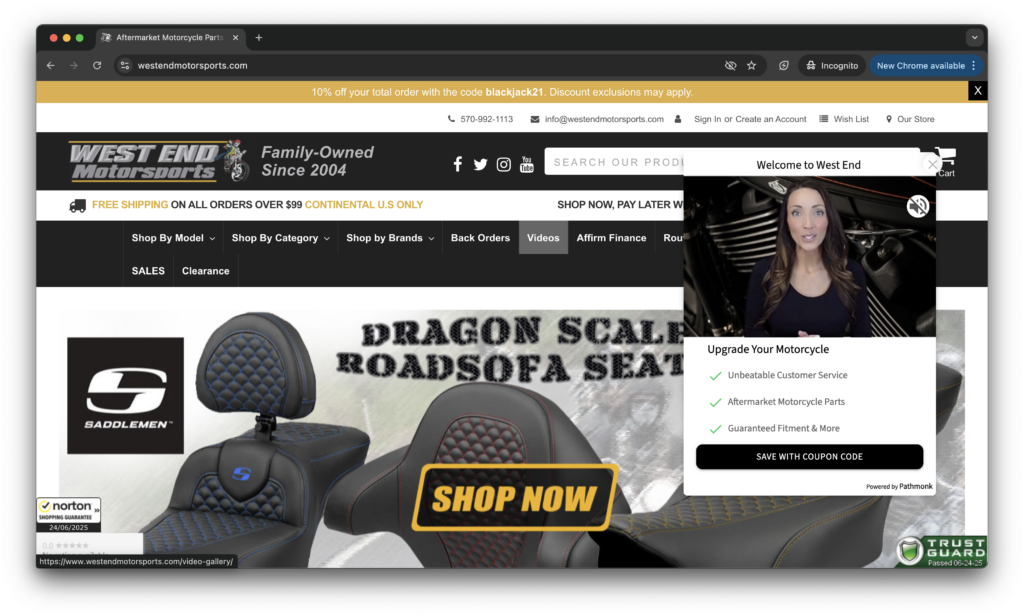
Here’s how the A/B test worked:
- Setup: Pathmonk was installed in just a few minutes. The team defined their main goal—drive more checkouts—and configured Pathmonk to recognize visitor behavior automatically.
- Split testing: The site traffic was divided evenly:
- 50% Control group: Visitors saw the standard website experience with no personalization.
- 50% Test group: Visitors were shown dynamic micro-experiences tailored to their journey stage.
- Personalization in action: Depending on each visitor’s behavior and intent signals, Pathmonk displayed relevant experiences, including:
- Product guides to help with compatibility questions.
- Video explainers for first-time buyers.
- Social proof and customer testimonials to build trust.
- Limited-time incentives to motivate faster decisions.
Because Pathmonk works without cookies, setup was privacy-safe and didn’t require development work. Everything was automated: once installed, the AI selected and displayed the right content in real time.
The results after just 14 days were clear:
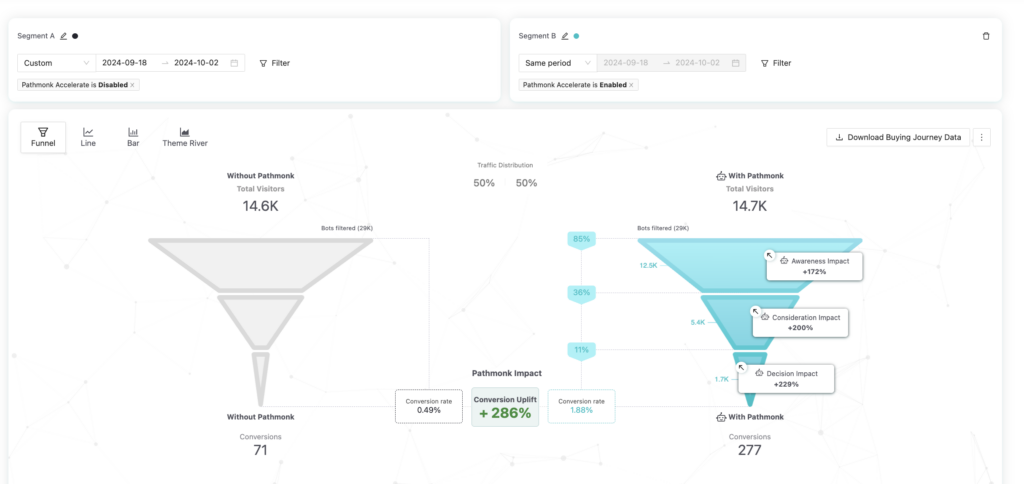
- Conversion rate: Jumped from 0.49% to 1.88%—a +286% increase.
- Conversions: Increased from 71 orders to 277 during the A/B test period.
- Funnel lift: Every stage of the customer journey improved:
- +172% more engagement in the awareness phase.
- +200% lift in the consideration phase.
- +229% more conversions at the decision stage.
No additional traffic or paid media was needed, this was purely the result of testing how personalized experiences outperformed static content.
Once the team reviewed the data, they felt confident enough to ramp up Pathmonk’s exposure to 95% of all visitors, making personalization their new default approach.
This is exactly what makes Pathmonk’s A/B testing so powerful: you don’t have to guess whether personalization works. You can measure it in a controlled, transparent way—side by side with your existing experience—and see real numbers before you decide to scale.
FAQs
1. Why does conversion rate often dip during the summer months?
It’s normal to see a noticeable dip in conversions during summer—especially in July and August. This slowdown is largely driven by shifts in buyer behavior. Decision-makers are out of office, procurement processes get delayed, and even motivated prospects may put off non-urgent purchases until after vacations. In B2B environments, buying committees often require multiple approvals, so when even one stakeholder is away, deals stall. In B2C, people spend more time traveling or focusing on leisure activities, which naturally reduces engagement with products and services outside of seasonal purchases.
Importantly, this decline doesn’t necessarily mean your campaigns or website have stopped working. It’s simply a reflection of predictable seasonality. That’s why smart marketing teams prepare for it in advance and adjust expectations. If you treat the summer slowdown as an opportunity rather than a crisis, you can focus on long-term improvements—like fine-tuning messaging, optimizing the customer journey, and testing new experiences—so you’re ready to capture demand when activity rebounds in September.
2. Which industries are most affected by the summer slowdown?
The summer slowdown tends to hit B2B industries the hardest, especially those with long sales cycles or complex decision-making processes. Sectors like software-as-a-service (SaaS), consulting, enterprise technology, and industrial services often experience a pronounced dip in activity. This is because B2B purchases typically involve multiple stakeholders—procurement managers, legal teams, budget approvers—and when even a few of them are out on vacation, deals stall. You’ll often see longer email response times, delayed meetings, and prospects going quiet until September. Even in well-established funnels with consistent traffic, conversions can temporarily drop as priorities shift toward internal planning or simply taking time off.
On the B2C side, it depends heavily on the product category. Businesses selling back-to-school supplies, travel services, outdoor equipment, and summer apparel often see a seasonal boost. In contrast, brands offering products that feel less urgent—like home improvement services, financial products, or enterprise learning tools—may experience lower engagement during the warmer months. That’s why it’s so important to benchmark your performance against historical trends rather than panic if conversions dip. If you know your industry is prone to seasonal swings, you can proactively plan by using the quieter period for optimization, testing, and refreshing your marketing strategy so you’re prepared when demand inevitably returns.
3. What makes summer a good time to work on conversion improvements?
Summer is often the only time in the year when marketing teams finally have the breathing room to focus on strategic projects that get deprioritized the rest of the year. With fewer launches, fewer urgent deadlines, and less day-to-day chaos, you can step back and objectively review what’s working in your conversion funnel—and what isn’t. This clarity is hard to find when you’re in the middle of high-traffic seasons and constantly reacting to campaign performance.
Another reason summer is ideal is that any improvements you make now will compound over time. For example, if you discover and fix friction points in your checkout flow or update your messaging to better match customer expectations, those changes will pay off when demand surges again in Q3 and Q4. Instead of scrambling to optimize under pressure, you’ll already have a stronger foundation in place. In other words, investing in your website experience during the slower months helps ensure you don’t just recover when traffic returns—you accelerate.
4. How long should I run A/B tests when traffic is lower?
When traffic is lighter, A/B tests naturally take longer to reach statistical significance. That’s because you need enough visitors in each variant group to produce reliable results. For example, if a test would normally run for two weeks during your peak season, you should expect it to take four to six weeks over the summer. This slower pace can feel frustrating, but it’s critical not to call winners too early—doing so increases the risk of making decisions based on random fluctuations rather than actual performance differences.
The good news is that summer gives you the time and space to let these tests run properly. Because you’re not under pressure to hit immediate revenue goals, you can focus on collecting clean, trustworthy data. This is especially valuable when you’re testing bigger ideas—like whether personalization drives more conversions than static experiences. Using tools like Pathmonk, you can split your audience evenly, measure performance over an extended period, and build confidence in the results. When traffic picks up again, you’ll know exactly which improvements deserve to be scaled.
5. What are some low-effort ways to improve conversions during summer?
If your team is smaller or you don’t have the capacity for big projects, there are still plenty of quick wins you can tackle during the summer. Start by refreshing your messaging—review your headlines and calls to action to make sure they clearly communicate value and feel current. Updating testimonials, customer logos, and product images can also boost credibility without requiring design resources. Even small tweaks, like simplifying your navigation menu or improving how you present pricing, can reduce friction and help visitors make faster decisions.
Another low-effort strategy is to set up basic personalization. For example, with Pathmonk, you can automatically adapt content to each visitor’s intent and journey stage without manual rule-building or development work. This can be as simple as showing returning users a more direct call to action or highlighting a limited-time incentive. These kinds of changes don’t require months of planning but can have an outsized impact on engagement and conversions—especially when traffic picks up again.
6. Is it worth investing in personalization if I don’t have a lot of traffic right now?
Yes—summer is actually one of the best times to start experimenting with personalization, even if your traffic volume is lower. The reason is simple: lower stakes mean you have the freedom to learn without risking significant revenue disruption. If you wait until your busiest quarter to roll out personalization, you’ll likely feel pressured to see immediate results, which can lead to rushed decisions or incomplete testing.
By starting during the slower season, you give yourself time to understand what resonates with different audience segments. You can A/B test personalization against your usual experience and build confidence in the results before scaling up. Tools like Pathmonk make this process easy by automating both the personalization and the measurement. So when your high-traffic periods return, you’ll already have proven, optimized experiences ready to go—setting you up for a stronger finish to the year.

